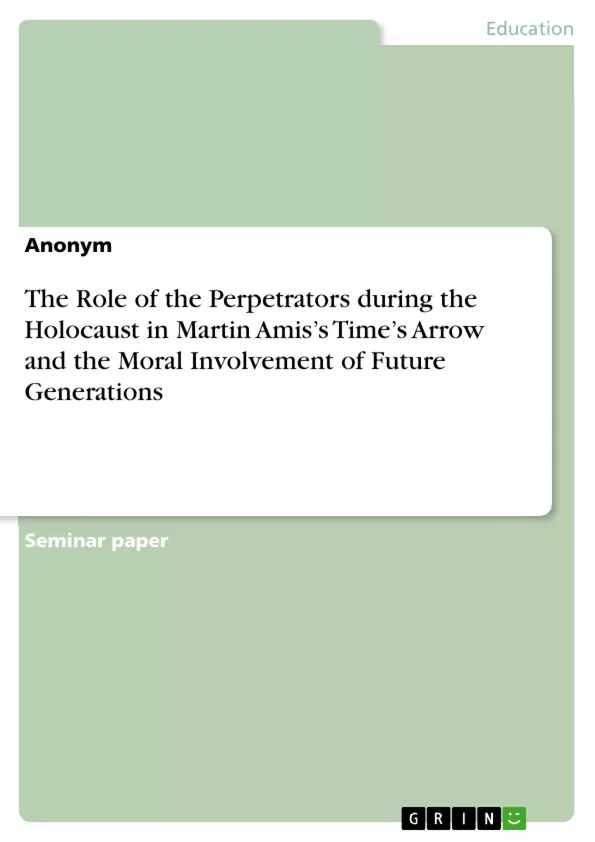“A literary text not only exploits and reallocates cultural discourses and meanings, it also may have such an influence on them that it becomes a medium of cultural memory, contributing to the formation as well as the perpetuation of cultural identity.“ The present research paper raises the question how Martin Amis’s Time’s Arrow contributes to such cultural discourses and meanings (regarding content). The novel will be analyzed in terms of how it portrays the perpetrators of the Holocaust and which conclusions can be drawn from this specific point of view. The significance of the Holocaust for future generations will also be outlined. The style as well as the content of the novel will be taken into account to analyze how morality is portrayed (2.1. Morality and the ‘Third Reich’) and what consequences arise from this (2.2. Consequences of ‘Third Reich’ Morality). In this respect, the role of the reader in relation to the text will be elucidated (2.3. Moral Involvement of the Reader). The method of analyzing content and style of the novel seems crucial to provide an answer to the raised question: “Personally, I’ve always believed in the indivisibility of form and content. […] Style is not neutral; it gives moral directions.” “Style isn’t something added on; it’s intrinsic to the perceptions and the way you see life.”
Postmodern theories of history point out that historical objectivity can not be accomplished: “[…] historians inescapably interpret, and thus shape, the history they want to document.” Particularly, Hayden White stresses the “construct character” of historical conclusions. “[T]here is an inexpugnable relativity in every representation of historical phenomena.” Furthermore, in terms of dealing with and interpreting the Holocaust, one has to be aware of the circumstance that “the historical narrativization of the Holocaust raises not only aesthetic problems, but also moral issues” . Hence, portraying the Holocaust has untold faces. Apart from the difference between interpretations, the motivation to provide an interpretation differs. (For instance, the purpose of memory might be used to legitimate the existence and form of a state. ) The description of the Holocaust is part of a ‘cultural memory’. (The term is used here to “describe the complex ways of which societies remember their past using a variety of media.” )
Inhaltsverzeichnis (Table of Contents)
- Introduction
- Historical Debate
- Drawing Conclusions from the Presentation of the Holocaust...
- Morality and the 'Third Reich'
- Consequences of 'Third Reich' Morality
- Moral Involvement of the Reader
- Conclusion
- Works Cited
Zielsetzung und Themenschwerpunkte (Objectives and Key Themes)
This research paper examines Martin Amis's Time's Arrow in relation to the portrayal of Holocaust perpetrators and the implications for future generations. It explores how the novel contributes to cultural discourses surrounding the Holocaust and the formation of cultural memory. The paper analyzes the narrative style and content of the novel to understand how morality is presented and the consequences that arise. In doing so, the role of the reader in engaging with the text's moral implications is also examined.
- The portrayal of Holocaust perpetrators in Martin Amis's Time's Arrow
- The role of the novel in shaping cultural memory and identity
- The narrative techniques used to present morality and consequences of the 'Third Reich'
- The reader's engagement with the text and its moral implications
- The significance of the Holocaust for future generations
Zusammenfassung der Kapitel (Chapter Summaries)
The introduction sets the context for the research by exploring the historical debates surrounding the Holocaust and its role in forming national identity. It emphasizes the subjective nature of historical interpretation and the importance of acknowledging the complexity of the Holocaust.
The chapter "Drawing Conclusions from the Presentation of the Holocaust" delves into the narrative techniques employed in Time's Arrow, highlighting the temporal reversal, split perspective, and ironic narrative mode. It explains how these techniques contribute to the novel's interpretation and conclusions about the Holocaust.
The section "Morality and the 'Third Reich'" examines how the novel portrays the morality of the perpetrators and explores the implications of their actions. The chapter "Consequences of 'Third Reich' Morality" analyzes the lasting effects of the Holocaust and how the novel addresses the issue of moral responsibility.
Schlüsselwörter (Keywords)
This research paper focuses on key themes such as the Holocaust, cultural memory, historical interpretation, narrative techniques, morality, responsibility, and the role of the reader. It explores the work of Martin Amis, focusing on his novel Time's Arrow and its contribution to cultural discourses surrounding the Holocaust.
- Arbeit zitieren
- Anonym (Autor:in), 2009, The Role of the Perpetrators during the Holocaust in Martin Amis’s Time’s Arrow and the Moral Involvement of Future Generations, München, GRIN Verlag, https://www.grin.com/document/146786



